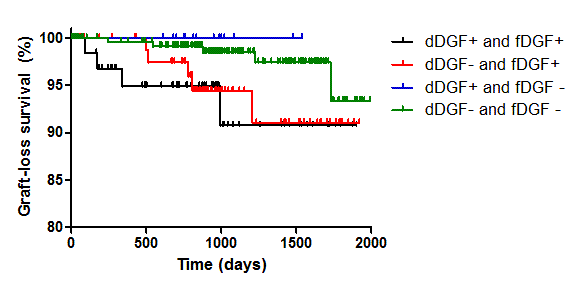Impact of Functional Delayed Graft Function in the Modern Era of Kidney Transplantation
Renal Transplant Unit, Hospital Clínic, Barcelona, Spain
Meeting: 2019 American Transplant Congress
Abstract number: 411
Keywords: Graft survival, Kidney transplantation, Post-operative complications, Renal dysfunction
Session Information
Session Name: Concurrent Session: Kidney Complications: Late Graft Failure III
Session Type: Concurrent Session
Date: Tuesday, June 4, 2019
Session Time: 2:30pm-4:00pm
 Presentation Time: 2:42pm-2:54pm
Presentation Time: 2:42pm-2:54pm
Location: Veterans Auditorium
*Purpose: the classical definition of Delayed Graft Function (DGF) (i.e. need of dialysis during the first week after kidney transplant) depends on the physician attitude towards dialysis and therefore is not very specific. The definition of functional DGF, proposed 20 years ago (failure of serum creatinine to decrease by at least 10% daily on 3 consecutive days during the first week post-transplant), may reflect better the functional recuperation of the kidney after the ischaemia-reperfusion injury. However, no works have been published lately that reevaluate this definition in the modern era of kidney transplantation.
*Methods: analysis of the performance of both definition of DGF (dialysis-based, dDGF, and functional-based, fDGF) in 406 recipients of kidney graft (2013-2016) for predicting long-term death-censored graft failure. Median follow-up was 966 (759-1452) days.
*Results: Of the whole population, 80 patients developed dDGF (19.7%) and 149 developed fDGF (36.7%). 64 patients fulfilled criteria for both definitions (15.7%). Univariable Cox-regression analysis with death-censored graft failure demonstrated significant correlation of fDGF (HR 3.40 [1.14-10.18], p=0.03) but not of dDGF (HR 2.05 [0.64-6.56], P=0.22). This was confirmed at bivariate and multivariate analysis, in which the model was adjusted for the following covariates: Biopsy-Proven Acute Rejection (BPAR), recipient and donor age, type of donor (cadaveric/living), cold ischemia time and recipient of a previous transplant (Table 1). Patients with fDGF but without dDGF had a comparable outcome with patients who fulfilled both definitions. Moreover, the absence of fDGF in patients who needed dialysis after transplantation (dDGF) was associated with better outcomes (Figure 1).
*Conclusions: the definition of fDGF provided better and supplementary information about graft outcomes compared to the classical definition of dDGF in a modern series of kidney transplant recipients.
| Model | HR (95% CI) | P-value |
| UNIVARIABLE | . | . |
| dDGF | 2.05 (0.64-6.56) | 0.22 |
| fDGF | 3.40 (1.14-10.18) | 0.03 |
| BIVARIABLE | . | . |
| fDGF | 3.26 (0.99-10.66) | 0.05 |
| MULTIVARIABLE | . | . |
| fDGF | 3.74 (1.03-13.42) | 0.04 |
To cite this abstract in AMA style:
Cucchiari D, Molina-Andujar A, Montagud-Marrahi E, Rovira J, Diekmann F. Impact of Functional Delayed Graft Function in the Modern Era of Kidney Transplantation [abstract]. Am J Transplant. 2019; 19 (suppl 3). https://atcmeetingabstracts.com/abstract/impact-of-functional-delayed-graft-function-in-the-modern-era-of-kidney-transplantation/. Accessed December 22, 2025.« Back to 2019 American Transplant Congress

